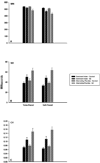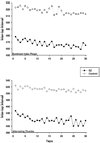Timing dysfunctions in schizophrenia as measured by a repetitive finger tapping task
- PMID: 19664870
- PMCID: PMC2783288
- DOI: 10.1016/j.bandc.2009.06.009
Timing dysfunctions in schizophrenia as measured by a repetitive finger tapping task
Abstract
Schizophrenia may be associated with a fundamental disturbance in the temporal coordination of information processing in the brain, leading to classic symptoms of schizophrenia such as thought disorder and disorganized and contextually inappropriate behavior. Although a variety of behavioral studies have provided strong evidence for perceptual timing deficits in schizophrenia, no study to date has directly examined overt temporal performance in schizophrenia using a task that differentially engages perceptual and motor-based timing processes. The present study aimed to isolate perceptual and motor-based temporal performance in individuals diagnosed with schizophrenia using a repetitive finger-tapping task that has previously been shown to differentially engage brain regions associated with perceptual and motor-related timing behavior. Thirty-two individuals with schizophrenia and 31 non-psychiatric control participants completed the repetitive finger-tapping task, which required participants to first tap in time with computer-generated tones separated by a fixed intertone interval (tone-paced tapping), after which the tones were discontinued and participants were required to continue tapping at the established pace (self-paced tapping). Participants with schizophrenia displayed significantly faster tapping rates for both tone- and self-paced portions of the task compared to the non-psychiatric group. Individuals diagnosed with schizophrenia also displayed greater tapping variability during both tone- and self-paced portions of the task. The application of a mathematical timing model further indicated that group differences were primarily attributable to increased timing--as opposed to task implementation--difficulties in the schizophrenia group, which is noteworthy given the broad range of impairments typically associated with the disorder. These findings support the contention that schizophrenia is associated with a broad range of timing difficulties, including those associated with time perception as well as time production.
Figures



References
-
- American Psychiatric Association. Diagnostic and statistical manual of mental disorders. 4th ed. Washington, DC: Author; 1994.
-
- Andreasen NC. A unitary model of schizophrenia. Bleuler’s “fragmented phrene” as schizencephaly. Archives of General Psychiatry. 1999;56:781–787. - PubMed
-
- Andreasen NC, Paradiso S, O’Leary DS. “Cognitive dysmetria” as an integrative theory of schizophrenia: A dysfunction in cortical-subcortical-cerebellar circuitry? Schizophrenia Bulletin. 1998;24:203–218. - PubMed
-
- Bell MD, Lysaker PH, Beam-Goulet JL, Milstein RM, Lindenmayer JP. Five-component model of schizophrenia: Assessing the factorial invariance of the positive and negative syndrome scale. Psychiatry Research. 1994a;52:295–303. - PubMed
-
- Bell MD, Lysaker PH, Milstein RM, Beam-Goulet JL. Concurrent validity of the cognitive component of schizophrenia: relationship of PANSS scores to neuropsychological assessments. Psychiatry Research. 1994b;54:51–58. - PubMed
MeSH terms
Grants and funding
LinkOut - more resources
Full Text Sources
Medical
Miscellaneous

